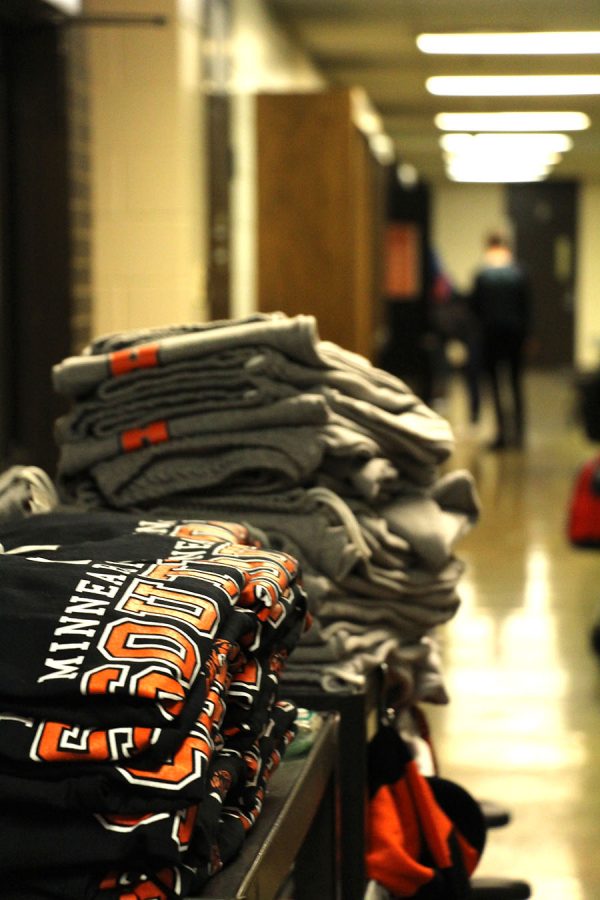What’s a sweatshop again? The issue that’s fallen out of view
South High’s tiger pride gear is sold during lunch every other Wednesday. The main brand used is Gildan which is notorious for using factories with sweatshop conditions. Merriam Webster defines a sweatshop as “a shop or factory in which employees work for long hours at low wages and under unhealthy conditions.” However, 37.2% percent of South students surveyed have never heard the term sweatshop before and 78.9% percent don’t clearly remember learning about it in school. South students could play a part in creating change on the issue but not if they don’t have access to the information about what’s actually going on.
As I walk through a busy H&M, Mariah Carey blasting through the speakers, searching for something I can buy with the ten dollars cash I have in my pocket, a thought flashes through my mind for just a second. Where is all this stuff being made? My want for cheap clothes overrides that question as I return to look through the racks.
People are constantly looking for deals and don’t always realize what is sacrificed to keep clothing prices low. Myself included. South sophomore Leo Peterson said, “I don’t know many people who go into a store and look into whether what they buy was made in a sweatshop.”
As I walked around the halls to ask students their opinions on the use of sweatshops the first question many asked me was, “What’s a sweatshop again?” This was a really good question because even I, the one writing about it, couldn’t give a definitive answer.
37.2% percent of South students surveyed have never heard the term sweatshop before and 78.9% percent don’t clearly remember learning about it in school.
Merriam-Webster defines sweatshop as, “a shop or factory in which employees work for long hours at low wages and under unhealthy conditions.” As far as I could get from scanning pages of academic essays and government reports the term, sweatshop is not defined in any federal law or regulation, but the U.S. General Accounting Office does define the term as, “a business that regularly violates both safety or health and wage or child labor laws.”
Students aren’t just completely ignoring the reality of where the things they buy are coming from; most just haven’t been exposed to the information. South Sophomore Hamze Jama thinks the issue of sweatshops isn’t as talked about because “[students] don’t hear about. It’s just that we don’t have people sharing it or people that wanna show us.”
During lunch, every other Wednesday, the South High Foundation sells sweatshirts, t-shirts and other South High pride items. The most used clothing brand is Gildan. You might have heard of them before. South Sophomore Frances Levy said to me, “I’m not surprised, literally everyone who makes a sweatshirt uses Gildan,” when I told her what company made the sweatshirts.
If you haven’t heard of Gildan, they’re just another multimillion dollar clothing company that sells basic items you can buy in bulk to turn into promotional products like the South merchandise. In the past they have been the center of a lot of controversy.
The tags of all Gildan products from South state that they were made in Honduras. South social studies teacher Richard Nohel said, “I still haven’t found anything to contradict my belief that nearly 90 percent of anything that’s made in Honduras is made in a sweatshop.” Therefore, it is highly likely that the sweatshirts and t-shirts sold by South are made in sweatshop conditions.
One argument in support of sweatshops is that people working in sweatshop factories would be living in even worse conditions if they didn’t have access to their factory jobs. Many countries that American companies outsource have a much lower cost of living. If large companies want to help impoverished people they could raise wages and fix conditions.
“The bottom line is that [major companies] could still pay [workers] even more and I think that really the crux of the matter,” Nohel said.
All websites of major companies like Gildan all have something in common: corporate codes of conduct. The codes are a documents that state the company’s responsibility to protect their workers and the environment. These codes are misleading because they are not legally binding and it’s difficult to hold them accountable. “You can go on any corporate website and find these things but whether the suppliers are actually following them is a completely different story,” said Nohel.
The challenge with holding companies accountable is how hard it is for the information about poor working conditions to reach the public. In the past, journalists have gone into factories and documented the realities of the workers to bring the issue into the media. This is where the voices of young people can make a difference.
South photography teacher Corbin Doty believes teaching people about the issue of sweatshops could create change. “The pressure…to [get] rid of sweatshops… a lot of that was because of photography and really brave photographers who went into these places and photographed the children [working],” Doty said.
The responsibility of buying from ethical brands can not only be up to the individual, it’s also up to institutions. Individuals who commit to only buying from these brands may make a small difference but major organizations can make much more of an impact.
Many of South students feel that if our school wants to act responsibly we need to change the source of our promotional products. South junior Jude Nair said, “if you really want to do things to help people who are in situations like that, you need to make sure you have quality guarantee of the conditions your fabric is made in.”
If South students knew about the harsh conditions people experience around the globe in order to make the clothes and products consumers purchase they might feel more of a responsibility to speak out. We may be just one school, but change happens through small steps of action. If South changes our source of promotional clothing, it could create a chain reaction that would spread much further than just our school.

Talula Cedar-James has a knack for tinkering with problems until they work. She is putting this skill to good use this year as she enters her second year...











Alasdair Carmichael • Dec 23, 2018 at 4:31 pm
First point to make is that I have no business or investment relationship with Gildan, but I am deeply connected with the US and global textile industry.
I suggest that before writing a piece it would be sensible to do a little basic research to determine some facts about the subject. I do not feel a quick chat with a social studies teacher qualifies as even the slightest amount of worthwhile research.
There is no doubt that sewing apparel is a labor intensive activity at the manufacturing end and a very price competitive product at the consumer end. So, yes wages are low and virtually all apparel manufacturing is done in low wage countries similar to Honduras, Vietnam, Bangladesh etc for this reason – look at the tags on your clothes.
Gildan has come in for some criticism for its labor policies, but has made major efforts recently to improve and become much more community oriented and socially responsible, see http://www.gildancorp.com/documents/2017-Genuine-Responsibility-Report-and-New-Website/Press-Release-CSR-report-and-website_Final.pdf
Gildan has grown its business substantially over the last 10 – 15 years and in a number of cases has purchased US operations and closed manufacturing and moved it to Central America. American Apparel is a recent example that some of your readers may be familiar with. However, in contrast to many of its competitors, Gildan has also grown its manufacturing in the US, but it is selective in what it does in the US. Over the last few years it has built 4 large yarn spinning plants in NC. Major capital investments bringing significant quality jobs to the region. The plants are highly automated and highly capital intensive – the only type of manufacturing that can survive in the US.
My advice, keep up the efforts to inform, but do some real research before publishing.
Hosted PBX Dallas • Dec 22, 2018 at 9:42 pm
Excellent post. I want to thank you for this informative read, I really appreciate sharing this great post. Keep up your work.